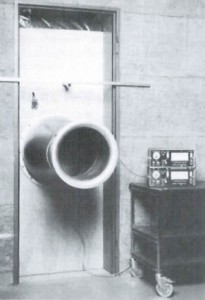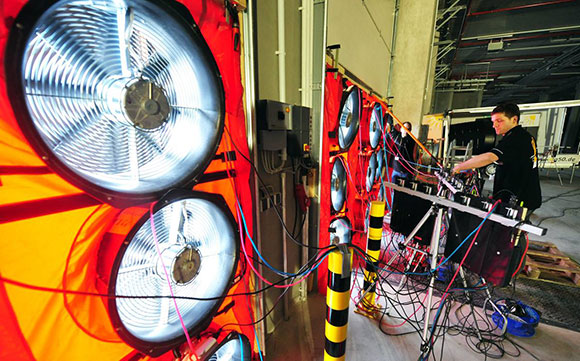Podcast: Play in new window | Download | Embed

What is a blower door and why would you want to use one?
Thomas van Raamsdonk is a home performance expert. He’s also an expert educator and can often be found touring New Zealand and Australia talking with design professionals, builders and clients about the virtues and techniques of better building.
During his career of researching high performance building around the world, Thomas has conducted hundreds of blower door tests and has seen the industry grow in popularity and sophistication. Now as General Manager for Pro Clima Australia and New Zealand, Thomas is one of the best advocates for good building science and building practices in the region.
We’ve discussed the benefits of airtightness previously. In this episode, we’re jumping straight in to look at the blower door.
What is a Blower Door?
There are three main parts to a bower door:
- A fan
- A flexible ‘door’ that seals around an opening in a building, typically an doorway
- A pressure gauge

How the Blower Door Works
Once set up into the opening, the fan of the blower door is used to either suck air out of the building (depressurise) or blow air into the building (pressurise) in order to create a pressure difference between the outside and the inside. Typically measurements are taken at a pressure differential of 50 Pascals across the building envelope. This high pressure difference, which is greater than what a building would experience during a severe storm, is chosen to minimise other influences like internal stack effects, changes in ambient air pressure and weather conditions on the day of the test.

At 50 Pascals a measurement can be taken (by the speed and flow rate of the fan) to determine how much air is having to be pumped into or out of the building in order to maintain the pressure. If the building was completely sealed, like a balloon or a bicycle tyre, either the pressure would keep rising, or once 50 Pascals was reached, the fan could be stopped and the pressure difference would remain.
But a building is never completely sealed. The leakier it is, the higher the flow rate from the fan will be in order to maintain the pressure difference.
The flow rate is then compared with the total volume of the house and a final figure is usually expressed as the number of air changes per hour (ach) at 50 Pascals, or ‘N50’. This can be thought of as the number of times that the entire volume of building is replaced, each hour.
Efficiency and Airtightness
At moderate rates of infiltration (‘leakiness’), the true air changes per hour at normal, ambient air pressure is approximately 0.05 x N50.
Ambient infiltration ≈ N50 ÷ 20
For example, an airtightness test of 5 ach at 50 Pa is equivalent to about 0.25 ach at normal air pressure. Under normal conditions that means the entire volume of air in the building would be replaced every four hours.
In winter, this would be the same as heating your home from scratch every four hours, even with all the doors and windows closed.
For many homes, the situation is even worse than this.

How Airtight are Homes?
New Zealand homes built before 1960 are pretty leaky. They have an average N50 airtightness of over 18 ach. During the 60s through to the 90s we did a little better, getting down to 8-9 ach, largely with the help of aluminium joinery which tends to keep windows and doors more sealed than timber frames. Since 2000, typical homes have gone down as low as 4 ach. This is still much higher than many other parts of the world.
Germany requires 3.0 ach for naturally ventilated buildings and only 1.0 ach for mechanically ventilated, in the US it depends on specific location but typically about 2 ach, and the UK requires 8.3 ach (measured as 10 m³/hr per m²).
The Passive House standard is 0.6 ach.

3 Steps for Good Home
Thomas has three key steps to ensuring that a building performs well:
- Good design
- Careful construction
- Verification
A blower door can help with verification and ideally it would be done during construction to address any issues as they arise. As Thomas pointed out, having a builder nervously awaiting the results of a blower door test near the very end of a build, may make good T.V. tension for Grand Designs, but it’s not much use in the real world if you find a massive airtightness failure near completion. Much better to test during the crucial stages of construction. This could include:
- Checking that air barriers are installed correctly
- Checking that electrical and plumbing services haven’t penetrated the barriers without being properly sealed
- Checking that your expensive windows still seal properly after they’ve arrived on site and been installed
- Checking the final wall lining
Blower Door World Record
Big spaces can be tested for airtightness, using multiple blower doors networked together. Large houses or commercial buildings might use two or three at once. The current record…? 30 blower door simultaneously running to test this new warehouse in Germany. Check out the video.

Get a Blower Door Test
In New Zealand, go to Pro Clima for a list of blower door test providers.
In the US, check out Retrotec’s list of service providers or distributors of the Minneapolis Blower Door system.
In the UK, you could start with the members of the Air Tightness Testing and Measurement Association or the The Airtightness Testers’ Association
Leave a Reply